

This information was taken from the book: The Travels of Israel by Israel (Lyola) Tsmach, 2001.
The book describes Israel's journey, from the Baltic Sea, via the Arctic Circle to the Mediterranean. It is the autobiography of the Revisionist (Betar) movement member who was sentenced to prison, during the Stalin period, because of his escape from the Soviet Union with the goal of reaching Israel.
Here is the summary and translation, from the Hebrew, of the chapter "My Father's House". It was translated by Esther (Herschman) Rechtschafner.
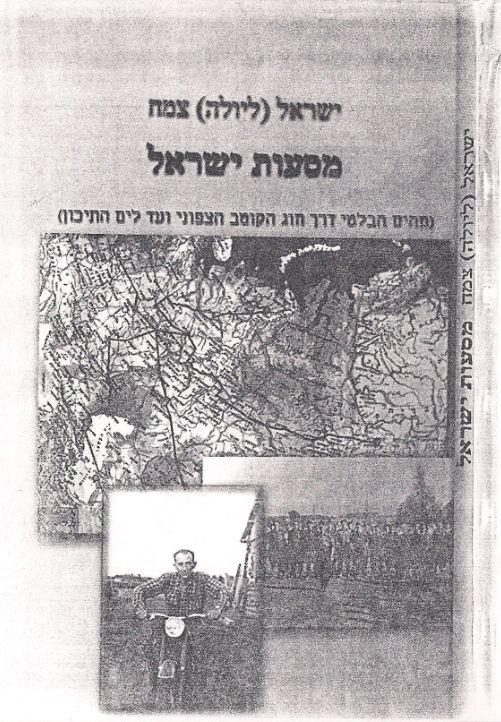
Title Page
My father, Raphael Nachman Tsmach, was born in 1896 in the city Pedruisk that is located in the Vitebsk district of Czarist Russia. He was an active member of the social Revolution Party, which believed in terror. He joined the revolution in 1917. The area was then under the rule of "White Russia" which was against the revolution. His oldest brother received the death sentence because of his party affiliation and actions. When my father was sentenced to jail, he escaped. At first he went to the town of Indra, which was located on the border. He lived in an inn that was owned by Chaim Elchanan Yoffe, and married the innkeeper's daughter.
My mother was born in 1893. She was a true "Jewish Mother". She liked to do handiwork and decorated the house nicely. Many women came to learn from her. Detectives came to look for my father. Because of a mistake in the spelling of the family name they did not find him. In November 1918 Latvia, Estonia and Lithuania declared themselves as independent republics. Pedruisk was then part of Belarus. Therefore al l of my father's family, including Nachum Tsmach (one of the founders of Habima the Israel Theater) was in Soviet territory.
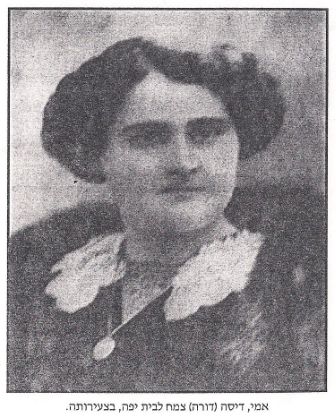
My mother Disa (Dora) Tzmach (nee Yaffe), when she was young
My parents moved to Rezekne, for my mother's brother (Zvi Hirsh Yaffe) lived there. He was a well-of merchant, an owner of a large factory and of a large apartment house. After a short while, by way of bribing, my father became a citizen.
My father was an educated person. He was active in various organizations. He was asked to be chairman of the merchants' organization. My older brother was born on 1919, and I was born on Simchat Torah 1921. Our sister Sarah was born in 1924 and our youngest brother Ephraim in 1929. The economic status of the family improved and we moved to a large six room house. We had a nice library.
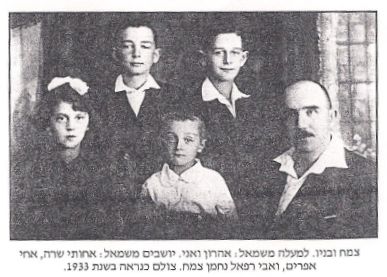
Tsmach and his children. Top, from the left" Aaron and me.
Seated Sarah,
Ephram and our father. 1933
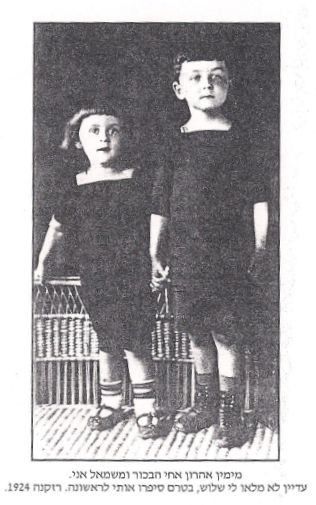
My older brother Aaron and me. I was not yet 3 years old.
It was taken before I got my first haircut. Rezekne 1924

This is what our street looked like in 1910. Our family moved
to the house
(with the circle sign) on it in 1926.
Our father was in charge of "Lapas" a large leather factory in Riga. Our mother was in charge of the outlet store in Rezekne. We had a live-in maid, a cook and a nanny. The factory was shut in 1930; but we continued to live on this level because the store.
Rezekne was one of the most beautiful and important cities in Latvia. Then it was the fourth largest city. The train station was a crossroad: Moscow, Riga, Leningrad, and Warsaw. Most houses were of one or two storeys. Most had a big yard and a garden. The city was very green and was cut in half by a river. The surrounding area had lakes, forests, hills, and streams in it. When I was young, I thought that the city was extremely large.
After WWI, the population was about 14,000, and about 4,500 were Jews. Since the Jews lived mostly in the city, it seemed that most of the population was Jewish. The Jewish community was very united and there were many activities. There were many Synagogues, libraries, clubs, and 4 elementary schools: 1 where the language of education was Hebrew 2 where the language was Yiddish, and the fourth was a religious school "Torah and Derech Eretz (righteous ways)". There was a gymnasia where the language was Yiddish. It was also open to students from the surrounding area.
I attended the Synagogue on Shabbatot and holidays, until the age of my Bar Mitzvah. Our home, as were most Jewish homes was traditional (kosher food and Shabbat and Holidays according to Jewish law). I remember preparations for Passover that began before Purim: the special dishes, the preparation of wine from raisins, the basket for that Matzaot that had to be sealed, so children would not eat of it before the holiday.
Chanuka was a happy holiday for children. There was no school. We played cards and with a top (with money). It was winter so we used our sleigh. There was an ice-skating rink with background waltz (Strauss) music.
The Jewish children were not very religious. They became active in political Youth organizations. The youth organizations were: BUND (Markist and anti-Zionist), Betar, HaShomer HaZair, Herzliah, General Zionists, and Gordonia.
The Jewish community had social aid and culture. There were 2 Rabbis. There was a "town fool". Most people were influenced by "Agudat Israel (very Orthodox), but also contributed to Zionist organizations. There was a blue and white charity box for the Jewish National Fund in every house. Today, as I look back, I can see how well organized the community was.
Most of the doctors were Jews. Our doctor did not take money from the poorer needy people and gave them medicines.
When I was 5, I went to kindergarten. The first day, I learned "and G-d created the heavens and he earth". Therefore my first memory of school has a connection with the creation.
We received a Zionist education, since most of our teachers were Zionists. They were also very good and devoted teachers. My teacher requested that I go to the Yeshiva. I did for a year; but didn't like it. I liked to study geography, history, mathematics, and I hated languages and grmmar.I once received a mark of "very good" for the contents of a composition; but "bad" for the spelling mistakes. I liked to read. I read classics, adventure stories and the Bible

Fourth grade in the Hebrew school, 1931. The teacher and principal of the school, Rachael Rabinowitz, who was also one of the founders is seated in the center. She was brutally murdered in the Holocaust, when the Nazis captured Rezekne in 1941.
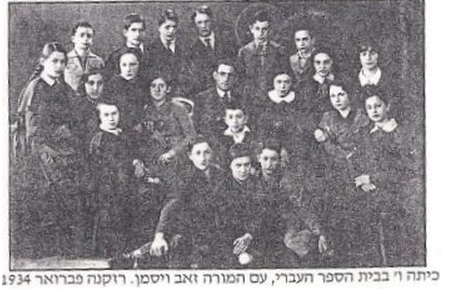
Sixth grade in the Hebrew school, with the teacher Zev Viseman
in the center.
February 1934.
The Betar (Zionist Revisionalists) Organization
At about the age of 7-8, I joined the Betar organization. The worker in our shop was in charge of the local organization and I was very impressed by him. Betar became a second home for me, and I participated in about all the activities. A representative came from Palestine and stayed in our house.
I felt that studying in high school was a waste of time. I believed that it was important to learn a trade to be useful in my future life in the Land of Israel,>myperents did not succeed in changing my mind.
In 1933, I went to study in the Jewish trade school in Riga, where students also got a diploma for academic studies. I lived with my cousin Sonia Yaffa Politsky. She and her family stayed in Riga during the WAR, and were murdered.
I returned to Rezekne and began to studying the Latvian trade school. I was the only Jew in the school. At the same time, I continued to be very active in Betar. All the members of these Zionist Jewish youth groups knew that they had to be prepared for hard work, in order to come on Aliyah. Every organization had a Hachshara (preparation) program.
In March 1939, when I was 18, I went to Hachshara in Vananz., Then were 20 boys and 10 girls participated in the program. We did farm work. We studied the idealogy of the movement. My dream was to be in Israel, work and be an Etzel fighter.
The work I liked best was with the horses and cows. One day, I could not find the cows. They had escaped to a neighboring farm. Luckily, they were returned and there was no tax payment. I was afraid of what the agricultural director David Karshtat would say. I got what I deserved. He later became mayor of Kiryat Gat, Israel.
The Latvians of the area laughed at us. They did not believe we could succeed. After the harvest, I was one of the two picked to go to help all the local farmers with the seeds. We were sent to prove ourselves in work and in drinking. We succeeded.
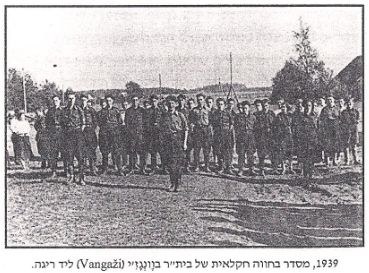
The Betar Agricultural farm at Vangzi, near Riga, in 1939.
I was sent from Hachshara to study to become a Betar commander. We studied army actics and organization, self-defense, and management. My brother had been on this course, and later joined in the Latvian army.
In 1939, I still thought I would be able to go on Aliyah. I knew that since I was a member of Betar, I could not get a "certificate" and my Aliyah would be illegal. The root that was usually taken was by way of Poland, joining with others there, and then to a port city on the Mediterranean. On September 1, 1939, the German army captured Poland.
I then became the manager of the group of Betar in Riga. I spent much time checking the finances of the movement. Life went on as usual, until June 1940.Then the Red army entered and conquered the Baltic States. The Betar movement issued a bulletin statingthat no more meetings could take place.
We had our last meeting in an alley and burned and buried everything that could be used as evidence. We heard of Jabotinsky's death and that there were instigators all over.
Before the WAR I had begun tiwork in"Turiba" a government run factory in Ludza. I was the only Jew working there. This was an Anti-Semitic factory. I got the job because my father had once helped the director. I was put on the "committee" even though it was known that I wasn't a communist. I was in charge of the warehouse.
Nazi Occupation
On September 17, 1939 Molotov signed the Molotov-Rebntrooff Agreement, which divided Poland between Germany and Russia. The Soviets were sure that Hitler would abide to this Agreement.
The Jewish population did not think of escaping' even after the Nazis moved east. On June 222, 1941 the Nazi soldiers captured Lithuania, western Latvia and entered Riga in July.
My friend Aryeh Polikov from Betar Rezekne came to me in Ludza and we decided to flee. We rode bicycle 30 kilometer until we reached the old Latvian-Russian border. We found it closed, and guarded by Soviet soldiers. He returned to Rezekne, and I to Ludza.
People started to flee. I joined them, with some of my Ludza friends. We crossed the border into Russia. All, I took with me was my bicycle, my fashionable leather jacket, and a few pictures. We were sure, we would be returning within a few weeks.
We rode about 120 Kilometer and reahed the Opochki province. There were many refugees there. There were about 2000 Jews in the railroad station. We stopped in a nearby forest, left our bicycles there and went to find out what was happening. We heard that along train was about to leave for the east.
Upon returning to the forest I discovered that my leather jacket was missing. We heard planes overhead and the area was bombed by the Germans. Russian soldiers checked that we had not parachuted from those planes. We were lucky that our documents were ok.
The next morning we boarded the train. We put the bicycles in the baggage car and received receipts. We did not see them again. No one knew where we were going.
I did not manage to say goodbye to my parents who were then in Rezekne, or my oldest brother who was then studying in the university in Riga. My father had previously received a truck for his work. He, my mother, sister and youngest brother went east. They reached the city Saratov and from there were sent to the small town Volsk. They lived there until the Germans left Latvia. My brother Aaron managed to leave Riga and reach my parents.
The week before the German army entered the Baltic States, on June 14, 1941, the Rezekne area was "purified". Heads of families were sent to Siberia. My uncle Zvi Hirsch Yaffe was among them. He was sent to the Viiatlag camp in the Kirov Province in March 1942.
Then His 2 sons were not in Rezekne. Later they faced their fate in the city.
Afterwards ,it became known that on Tisha BAv,1941, the Jewish population was taken to the Jewish cemetery and shot. Some were taken to Ancupanii and murdered there.
My 2 cousins, the sons of Zvi Hisch, Yisroel (Sortzka) and Shlomo Yaffe, the Hirsh family, Moshe and Benjamin Kagan, cousins of my mother- all of them were murdered in Rezekne in the summer of 1941.
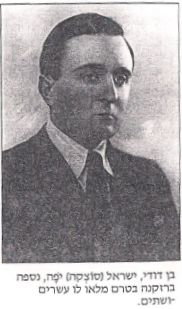
My cousin, Israel (Sotzke) Yaffe. He perished in the Holocaust
in Rezekne, before he was 20 years old.
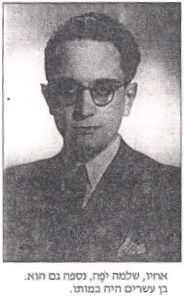
My cousin, Sclomo Yaffee. He also persihed in Rezekne,
in the Holocaust. He was then 20 years old.
To reach the author of any family article contact Esther or Dave at their email address below.
